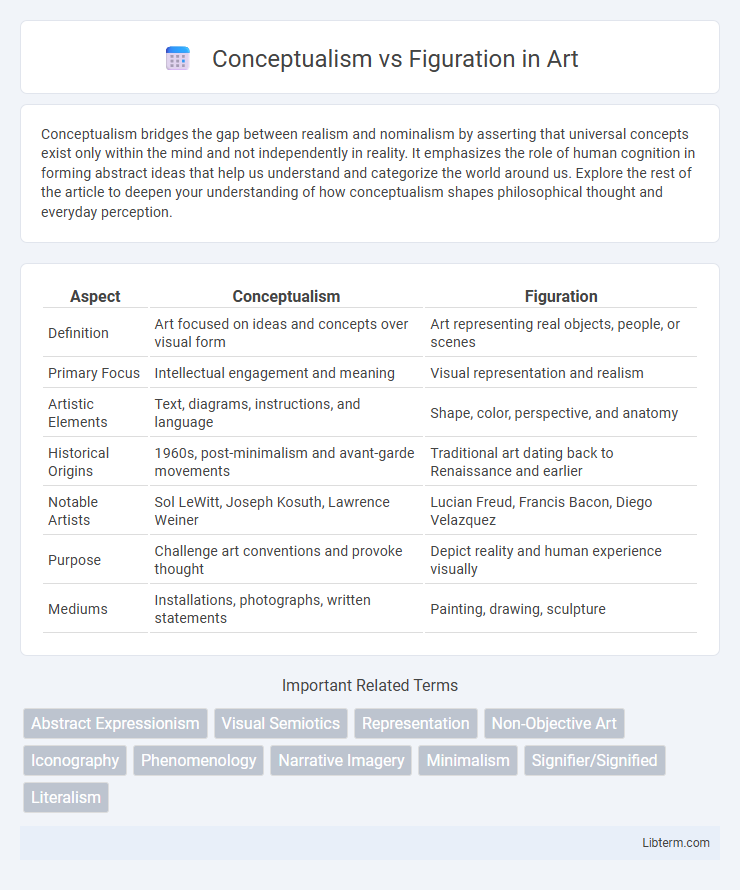Conceptualism bridges the gap between realism and nominalism by asserting that universal concepts exist only within the mind and not independently in reality. It emphasizes the role of human cognition in forming abstract ideas that help us understand and categorize the world around us. Explore the rest of the article to deepen your understanding of how conceptualism shapes philosophical thought and everyday perception.
Table of Comparison
| Aspect | Conceptualism | Figuration |
|---|---|---|
| Definition | Art focused on ideas and concepts over visual form | Art representing real objects, people, or scenes |
| Primary Focus | Intellectual engagement and meaning | Visual representation and realism |
| Artistic Elements | Text, diagrams, instructions, and language | Shape, color, perspective, and anatomy |
| Historical Origins | 1960s, post-minimalism and avant-garde movements | Traditional art dating back to Renaissance and earlier |
| Notable Artists | Sol LeWitt, Joseph Kosuth, Lawrence Weiner | Lucian Freud, Francis Bacon, Diego Velazquez |
| Purpose | Challenge art conventions and provoke thought | Depict reality and human experience visually |
| Mediums | Installations, photographs, written statements | Painting, drawing, sculpture |
Defining Conceptualism: Art Beyond Aesthetics
Conceptualism prioritizes ideas and intellectual engagement over visual aesthetics, emphasizing the artist's concept as the true essence of the artwork. This movement challenges traditional art by shifting focus from form, color, and technique to the communication of meaning and critical thought. In contrast to figuration, which depicts recognizable subjects, conceptual art often employs text, instructions, or unconventional materials to provoke reflection and question established art norms.
Understanding Figuration: The Power of Visual Representation
Figuration harnesses the power of visual representation by depicting recognizable forms, allowing viewers to connect emotionally and intellectually with the artwork. This approach contrasts with conceptualism, which prioritizes ideas over visual form, emphasizing the symbolic and narrative potential of imagery. Understanding figuration involves recognizing its capacity to communicate complex human experiences through relatable and tangible visual elements.
Historical Evolution: From Figuration to Conceptualism
The historical evolution from figuration to conceptualism marks a significant shift in art from representational imagery to idea-driven expression, emerging prominently in the 1960s. Figuration, rooted in traditional visual depiction, gradually gave way to conceptualism's emphasis on the artist's intention and intellectual engagement rather than aesthetic form. This transition redefined artistic value by prioritizing concept and meaning over literal representation, influencing contemporary art practices and critical theory.
Key Artists in Conceptualism and Figuration
Conceptualism features key artists such as Sol LeWitt, Joseph Kosuth, and Lawrence Weiner, who emphasize ideas over visual form, often using text and installations to challenge traditional art norms. Figuration is represented by artists like Lucian Freud, Jenny Saville, and David Hockney, focusing on the human figure and realistic or expressive representation in painting and sculpture. The distinction lies in Conceptualism's prioritization of intellectual engagement, while Figuration centers on perceptual experience and visual narrative.
Artistic Techniques: Concept versus Depiction
Conceptualism emphasizes the primacy of ideas over visual form, utilizing techniques such as text, diagrams, and minimalistic imagery to communicate complex concepts directly. Figuration relies on representational techniques, including detailed drawing, painting, and sculpting, to depict recognizable subjects and evoke emotional responses. The divergence lies in Conceptualism's pursuit of intellectual engagement through abstract means, while Figuration focuses on sensory experience via concrete visual representation.
Philosophical Foundations: Ideas Versus Images
Conceptualism emphasizes the primacy of ideas and intellectual engagement over visual representation, asserting that art's meaning lies in the concept rather than the physical form. Figuration prioritizes images and recognizable subjects, grounding artistic expression in visual experience and sensory perception. The philosophical foundation of Conceptualism challenges traditional aesthetics by valuing abstract thought, while Figuration maintains a connection to reality through visual depiction.
Audience Engagement: Interpretation and Perception
Conceptualism invites audience engagement through intellectual interpretation, prioritizing ideas over visual representation and encouraging viewers to decode underlying meanings. Figuration relies on recognizable imagery, facilitating immediate emotional connections and accessible narratives that shape perception. Both approaches shape how audiences interpret artworks, with Conceptualism fostering active mental participation and Figuration delivering direct visual impact.
Conceptualism and Figuration in Contemporary Art
Conceptualism in contemporary art prioritizes ideas and concepts over traditional aesthetic and material concerns, often using text, documentation, and non-traditional media to challenge the boundaries of art. Figuration remains central to contemporary art by representing recognizable forms and human figures, emphasizing narrative, identity, and emotional expression. The dynamic interplay between Conceptualism and Figuration highlights ongoing debates about meaning, representation, and the role of the artist in the 21st century art landscape.
Critical Debates: Valuing Process or Product
Conceptualism prioritizes the idea and intellectual engagement behind the artwork, emphasizing the creative process as the core value, whereas Figuration focuses on the representational outcome, highlighting aesthetic and emotional impact. Critical debates often center on whether the conceptual framework or the tangible, visual product holds greater artistic significance. These discussions challenge traditional art valuation by questioning if the essence of art lies in its execution or the theoretical context it conveys.
Bridging the Divide: Hybrid Approaches in Modern Art
Hybrid approaches in modern art seamlessly merge Conceptualism's emphasis on ideas with Figuration's visual representation, creating works that challenge traditional boundaries. Artists employ symbolic imagery alongside text or conceptual frameworks to engage viewers in both intellectual and aesthetic experiences. This fusion fosters innovative expressions that reflect contemporary culture's complexity and multifaceted nature.
Conceptualism Infographic

 libterm.com
libterm.com